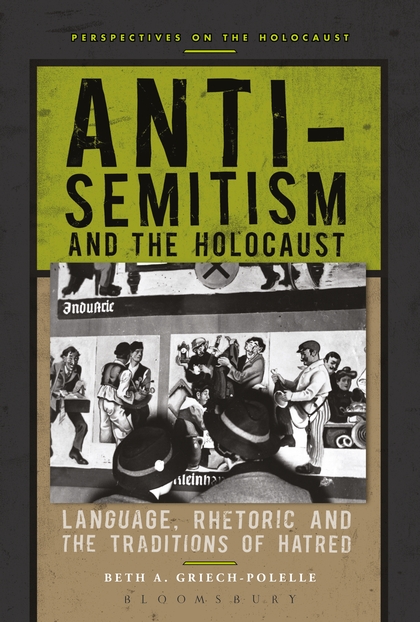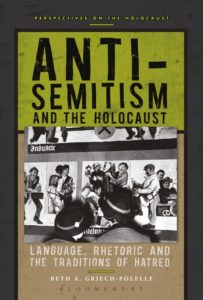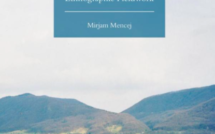
Anti-Semitism and the Holocaust: Language, Rhetoric, and the Traditions of Hatred by Beth A. Griech-Polelle
This is part of our special feature on Anxiety Culture.
 In Anti-Semitism and the Holocaust: Language, Rhetoric, and the Traditions of Hatred, Beth Griech-Polelle sets out to investigate the relationship between antisemitism, the construction of a German racial community, and the persecution and murder of Jews during the Second World War. Griech-Polelle does not set out to write a comprehensive history of the Holocaust nor of anti-Semitism. Rather,her focus is on the power of language, and how language and rhetoric can result in deadly actions. (1) This focus would be a welcome addition to the pool of introductory textbooks on the Holocaust. Unfortunately, because the book is intended as a textbook for undergraduate audiences, as well as the general public, the author finds herself in a predicament. She has to write an introductory history of the Holocaust and make a complex argument about the relationship between rhetoric and action. In seeking to do both, the result is a narrative that lacks analytical rigor and focus.
In Anti-Semitism and the Holocaust: Language, Rhetoric, and the Traditions of Hatred, Beth Griech-Polelle sets out to investigate the relationship between antisemitism, the construction of a German racial community, and the persecution and murder of Jews during the Second World War. Griech-Polelle does not set out to write a comprehensive history of the Holocaust nor of anti-Semitism. Rather,her focus is on the power of language, and how language and rhetoric can result in deadly actions. (1) This focus would be a welcome addition to the pool of introductory textbooks on the Holocaust. Unfortunately, because the book is intended as a textbook for undergraduate audiences, as well as the general public, the author finds herself in a predicament. She has to write an introductory history of the Holocaust and make a complex argument about the relationship between rhetoric and action. In seeking to do both, the result is a narrative that lacks analytical rigor and focus.
In the book’s first three chapters, the author lays out a useful analytical framework and provides readers with an overview of early and medieval Christian anti-Jewish beliefs and their subsequent transformation in the modern period. In the book’s remaining five chapters, Griech-Polelle examines how in Nazi Germany, anti-Jewish stereotypes and beliefs that defined Jews as existential enemies of the German people, served to delineate the boundaries of the German racial community. Over time, as the Nazi regime’s rhetoric became increasingly more radical, it cemented the notion that “in order for the German people, the Volksgemeinschaft, to live, Jews had to die.” (2)
Chapter 1 introduces readers to two of the central questions driving the study of genocide: Why do ordinary people become murderers and, sometimes, mass killers? And why do perpetrators make their victims suffer torture, deprivation and sexual violence before they murder them? To answer these questions, Griech-Polelle equips the reader with a three-pronged analytical framework. First, drawing on the French scholar Jacques Semelin’s work on mass violence, she notes how the rhetoric of extermination revolves around three themes: identity, purity, and security. This trinity in turn defines outsiders as seeking to defile, pollute, and ultimately destroy the insider community. The relationship between insiders and outsiders, in this case non-Jewish Germans and Jews, is thus, inside this rhetorical universe, a perpetual, existential struggle. (1) The second part of the three-pronged analytical framework that Griech-Polelle introduces, is the historian Thomas Kühne’s work on the relationship between antisemitism and the creation of the German racial community. Informed by Kühne’s insights, Griech-Polelle argues that as they yearned for and helped build a Germany racial community, ordinary Germans participated in the persecution and murder of Jews. Anti-Jewish rhetoric and actions thus helped delineate the boundaries of the Volksgemeinschaft. Participation in mass violence was part and parcel of a feeling of belonging as a German to a German community. (2) The third and last element in Griech-Polelle’s framework is Saul Friedländer’s concept of “redemptive antisemitism.” This is an ideology that drew on longstanding traditions of depicting Jews as a powerful evil force, be that the devil or Bolshevism, whose elimination was necessary in order to save humanity. It was thus a form of antisemitism that legitimized, even demanded, a preemptive strike against Jews. (2). While Griech-Polelle’s framework is useful, it would have been prudent to include a concise discussion of the historiography on the relationship between anti-Jewish ideology and murder. An overview of the Browning-Goldhagen debate alone would have sufficed to open up the topic for readers looking to understand the complexity between rhetoric and action.
After this introductory first chapter, Griech-Polelle turns to the long history of anti-Jewish beliefs and policies from early Christianity to the Enlightenment. In chapter 2, she discusses the evolution of the image of Jews as Christ-killers and of Jews as a rootless, rejected people, suffering degradation and persecution due to their own stubbornness and lack of generosity. This latter stereotype was popularized through the image of the Wandering Jew. (16-17) The chapter explores the relationship between anti-Jewish rhetoric and the worsening socio-economic conditions for Jews in western and central Europe in the Middle Ages before turning to the era of emancipation and nationalism and the changing status of Jews within French, German and Russian societies.
The third chapter centers on the rise of modern antisemitism. The author constructs a traditional narrative as she discusses the uses of anti-Jewish stereotypes in mass politics in the late 1800s in Germany, Austria, and France. In this chapter, the author’s tendency to include too much context, some which doesn’t seem relevant to the main goal of the chapter, is especially pronounced. For example, she includes a section here on Jewish responses, focusing primarily on Zionism. Aside from the fact that Zionism was a marginal movement within Jewish life at the turn of the century, going off on this tangent does little for readers seeking to understand why non-Jews embraced a new form of hatred of Jews. It is unclear what a discussion of Jewish responses adds at this stage in the book. About a third of this chapter is devoted to Germany’s WWI experience and again Griech-Polelle sticks to a familiar narrative. She focuses on the western front, the myth of the stab in the back, and the turmoil on the home front. Griech-Polelle thereby ignores important new scholarship on the significance for German rightwing nationalists of the German military’s and hence millions of German soldiers’ experience in Eastern Europe during the war. This was not trench warfare but a highly mobile war in which German and Austrian soldiers came into every day contact with local populations including the region’s large Jewish communities. The Russian and Austrian borderlands, which the German and Austrian militaries occupied for much of the war, were after all the heartland of Europe’s Jewish civilization. As Vejas Liulevicius has shown German soldiers experienced the East with a mixture of disgust and longing. For many, the encounter with Jews and other locals embodied the region’s backwardness and its peoples’ inferiority and thus the need for and legitimacy of Germans’ desire to civilize and dominate the East.[1] The Treaty of Versailles’ “redistribution” of the large territory in Eastern Europe that Germans perceived to have won legitimately in the war, contributed to the bitterness of the defeat of November 1918. Indeed, some of the most prominent early party activists and ideologues of the Nazi movement were men who were from or had fought in Eastern Europe. In terms of understanding the link between territorial expansion and genocide as well as the fierce hatred of Bolshevism and its alleged Jewish proponents imbedded in post-WWI antisemitism, the Eastern Front would have been much more relevant to discuss than the emergence of Zionism and its various factions.
Chapter 4 examines the Weimar years and the Nazi movement’s rise to power before turning to Adolf Hitler’s antisemitism and the ways in which it shaped policies and actions in the first years of Nazi Germany. The author notes how Hitler intermixed racial antisemitism with religious imagery. He was convinced, she argues, that rational, scientific antisemitism should be combined with “a more emotional appeal to the masses.” (76) Drawing on documents from the earliest days of the Nazi Party through the first years in power, the author argues that the Nazi movement’s public staging of and creation of opportunities for participation in attacks on Jews, whether verbal or physical, helped delineate the boundaries of the Volksgemeinschaft. Indeed, Griech-Polelle makes the claim that non-Jewish Germans were complicit on a mass scale in the persecution of Jews. Episodes of public humiliation or persecution were particularly significant in involving ordinary non-Jews and producing mass complicity. She argues that “even if one was a passerby, that individual was now complicit in the action […] once a person had witnessed one of these public shamings even silently choosing not to intervene [it] meant that a person was guilty of complicity.” (99-100) This is a highly charged claim. The author argues that public acts of persecution produced a shared guilt among non-Jewish Germans that in turn forged their racial community. Yet, the reader is never presented with evidence that supports this claim. Indeed, much like the claims of mass complicity, a position only substantiated by the author’s definition of complicity as simply presence (individuals’ intent and degrees of agency are not considered in this definition), the claims about guilt remain unsubstantiated.
Chapter 5 entitled “Turning Points” covers the period from 1936 to the fall of 1939. The chapter sets out to focus on the regime’s radicalization of anti-Jewish actions in order to shore up the Volksgemeinschatft as Germany prepared for war. It discusses topics such as eugenics policies, Jewish emigration, episodes of public humiliation of Jews, the Anschluss, the annexation of the Sudetenland, the occupation of the rest of Bohemia and Moravia and so on. While these themes might make chronological sense and are interconnected, the reader struggles to find answers to the book’s main question, namely the role and impact of antisemitism in shaping policies, actions, and ordinary people’s responses. Indeed, in the following three chapters that cover the German occupation of Poland and the ghettoization of Polish Jews (chapter 6); the German invasion of the Soviet Union and the descent into genocide with the deployment of reinforced mobile killing units (chapter 7); and the creation of killing centers and massive labor sites (chapter 8), the narrative loses complete track of the central question about the role of antisemitism. It reads like an introductory history of the Holocaust. And the missed opportunities for pursuing the original goal of the book are puzzling. For example, in her discussion of the role that local east Europeans played in assisting the German perpetrators, by attacking denouncing, exploiting, and at times murdering Jews, the author shies away from a careful analysis of why people participated and what role antisemitism played. Historians have shown that opportunities for enrichment, improvement of one’s social status, and uncertainty with regards to one’s position vis-a-vis the German authorities, were powerful incentives for ordinary people’s participation in mass murder and other crimes. In fact, this topic has been intensely researched in the last two decades.[2] Yet, the author simply notes that east Europeans have a “long history of pogroms and antisemitic attitudes […] so in many cases, the Nazis provided the excuse to enact violence against local Jews.” (180) This statement is not only an example of Griech-Polelle’s habit of not providing adequate evidence for problematic statements, but also a reflection of a lack of familiarity with conditions in German-occupied Eastern Europe. The book’s last chapter covers the creation of killing centers in formerly Polish territory and the last stage of the Holocaust, namely the death marches. And here the narrative ends, abruptly stating: “Hitler capitalized on preexisting stereotypes, myths, and legends about Jews in order to isolate and then persecute, and ultimately murder them. The Volksgemeinschaft accepted this bond. The end result was 5 to 6 million dead Jews.” (228)
As a textbook, Antisemitism and the Holocaust comes with a number of pedagogical tools. Most importantly, every chapter contains two primary document excerpts each of which has a short, helpful introduction as well as very useful questions for the reader to consider. For example, the chapter on religious antisemitism includes excerpts from the Gospels and Martin Luther’s “Concerning the Jews and Their Lies.” Yet, even in these sections, the selections sometimes appear tangential to the book’s focus or simply too short or complex to be useful to readers.
Other editorial decisions further undermine the book’s utility. For example, lots of space and effort is wasted on a “Glossary of Terms,” all of which can be easily and reliably found online. Yet, the book does not contain a single map! Furthermore, while it does contain some images, at times the captions are misleading and highly problematic. For example, one photograph shows orthodox Jewish inhabitants of Warsaw digging trenches under the supervision of Polish soldiers during the defense of the city against the invading Germans. Yet, because the image appears in the context of a discussion of German mistreatment of Jews, including brutalizing forced labor, the novice student of the Holocaust might be confused about the role of the Polish soldiers. (143, fig. 6.1) Another caption of an image is formulated in a way that suggests that the Nazis planned to use poison gas to murder Jews already in the late 1920s (206, fig. 8.1), an assertion few historians would agree with. The lack of attention that this book appears to have received from its editors and peer reviewers—from the absence of maps, to the problematic image captions, to the myriad of errors and typos, to the lack of analytical focus—undermines the quality and utility of the book. The topic is important and the concept for the book worthwhile, but it simply does not live up to its promise.
Reviewed by Tatjana Lichtenstein, The University of Texas at Austin
Anti-Semitism and the Holocaust: Language, Rhetoric, and the Traditions of Hatred
By Beth A. Griech-Polelle
Publisher: Bloomsbury Academic
Hardcover / 296 pages / 2017
ISBN: 9781472586919
To read more book reviews, please click here.
Published on July, 2 2018.
[1] Vejas G. Liulevicius, War Land on the Eastern Front: Culture, National Identity and German Occupation in World War I (New York, Cambridge University Press, 2005).
[2] Examples include Doris L. Bergen, “The Nazi Concept of ‘Volksdeutsche‘ and the Exacerbation of in Eastern. Europe, 1939-45,” in Journal of Contemporary History vol. 29, no. 4 (Oct., 1994): 569-582; Jan T. Gross, Neighbors: The Destruction of the Jewish Community in Jedwabne, Poland (New York: Penguin, 2002), and Jan Grabowski, Hunt for the Jews: Betrayal and Murder in German-Occupied Poland (Bloomington: Indiana University Press, 2013).




